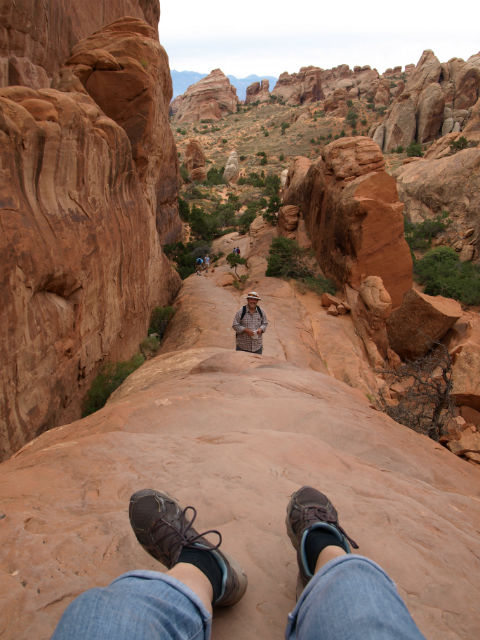The geology at Arches National Park in Utah is dizzying. (Even for someone with a geology background.)
But here’s what you really need to know: this is one popular park and it can become crowded. Tour buses. Gargantuan RVs. The whole nine yards. (We saw an RV with a bumper sticker that said: Does my RV make me look fat?). By 8:30am the cars and RVs are lined up at the entry. So, we set our alarm for 6am, were inside the park a half-hour later and on the Devils Garden Trailhead by 7am, just in time for sunrise.
We (almost) had the trail to ourselves – and after a fantastic 2.5-hour hike, on the way back we met throngs of people just starting. Climbing up was not so bad. Getting down was a seat-of-the-pants affair. So glad we got there early, hiked before it became too warm and could enjoy the quiet of the red sandstone formations.
Seriously though, the geology here gets complicated. (The Visitor Center has a very good movie that explains it all in a whirl.) A massive inland sea that filled and evaporated, filled and evaporated. All the while salt deposits are building up. Sediments were deposited on top of the rock, the layers buckled and the rock layers were thrust upwards creating domes which weathered over time to create the arches, pinnacles, red rock canyons and balanced rocks. This process took, oh … 300 million years.
An Arches cheat sheet:
- There are more than 2,000 arches in the park.
- Arches are a rarity in nature’s architecture.
- The arches were shaped by water.
- Given enough time, all arches eventually collapse.
- The rocks at Arches National Park are sedimentary.
- Get through the entry booth a half-hour before sunrise. Seriously.





300 million years. . . .!
O.M.G., my head just exploded. Really.